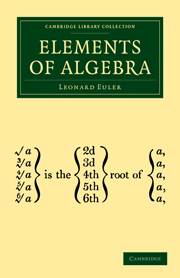Book contents
- Frontmatter
- ADVERTISEMENT
- MEMOIR OF THE LIFE AND CHARACTER OF EULER, BY THE LATE FRANCIS HORNER, ESQ., M. P.
- ADVERTISEMENT BY THE EDITORS OF THE ORIGINAL, IN GERMAN
- ADVERTISEMENT BY M. BERNOULLI, THE FRENCH TRANSLATOR
- Contents
- PART I Containing the Analysis of Determinate Quantities
- SECTION I Of the Different Methods of calculating Simple Quantities
- Chap. I OF Mathematics in general
- Chap. II Explanation of the signs + plus and − minus
- Chap. III Of the Multiplication of Simple Quantities
- Chap. IV Of the nature of whole Numbers, or Integers with respect to their Factors
- Chap. V Of the Division of Simple Quantities
- Chap. VI Of the properties of Integers, with respect to their Divisors
- Chap. VII Of Fractions in general
- Chap. VIII Of the Properties of Fractions
- Chap. IX Of the Addition and Subtraction of Fractions
- Chap. X Of the Multiplication and Division of Fractions
- Chap. XI Of Square Numbers
- Chap. XII Of Square Roots, and of Irrational Numbers resulting from them
- Chap. XIII Of Impossible, or Imaginary Quantities, which arise from the same source
- Chap. XIV Of Cubic Numbers
- Chap. XV Of Cube Roots, and of Irrational Numbers resulting from them
- Chap. XVI Of Powers in general
- Chap. XVII Of the Calculation of Powers
- Chap. XVIII Of Roots with relation to Powers in general
- Chap. XIX Of the Method of representing Irrational Numbers by Fractional Exponents
- Chap. XX Of the different Methods of Calculation, and of their Mutual Connexion
- Chap. XXI Of Logarithms in general
- Chap. XXII Of the Logarithmic Tables that are now in use
- Chap. XXIII Of the Method of expressing Logarithms
- SECTION II Of the different Methods of calculating Compound Quantities
- SECTION III Of Ratios and Proportions
- SECTION IV Of Algebraic Equations, and of the Resolution of those Equations
- PART II Containing the Analysis of Indeterminate Quantities
- ADDITIONS BY M. DE LA GRANGE
Chap. I - OF Mathematics in general
Published online by Cambridge University Press: 05 July 2011
- Frontmatter
- ADVERTISEMENT
- MEMOIR OF THE LIFE AND CHARACTER OF EULER, BY THE LATE FRANCIS HORNER, ESQ., M. P.
- ADVERTISEMENT BY THE EDITORS OF THE ORIGINAL, IN GERMAN
- ADVERTISEMENT BY M. BERNOULLI, THE FRENCH TRANSLATOR
- Contents
- PART I Containing the Analysis of Determinate Quantities
- SECTION I Of the Different Methods of calculating Simple Quantities
- Chap. I OF Mathematics in general
- Chap. II Explanation of the signs + plus and − minus
- Chap. III Of the Multiplication of Simple Quantities
- Chap. IV Of the nature of whole Numbers, or Integers with respect to their Factors
- Chap. V Of the Division of Simple Quantities
- Chap. VI Of the properties of Integers, with respect to their Divisors
- Chap. VII Of Fractions in general
- Chap. VIII Of the Properties of Fractions
- Chap. IX Of the Addition and Subtraction of Fractions
- Chap. X Of the Multiplication and Division of Fractions
- Chap. XI Of Square Numbers
- Chap. XII Of Square Roots, and of Irrational Numbers resulting from them
- Chap. XIII Of Impossible, or Imaginary Quantities, which arise from the same source
- Chap. XIV Of Cubic Numbers
- Chap. XV Of Cube Roots, and of Irrational Numbers resulting from them
- Chap. XVI Of Powers in general
- Chap. XVII Of the Calculation of Powers
- Chap. XVIII Of Roots with relation to Powers in general
- Chap. XIX Of the Method of representing Irrational Numbers by Fractional Exponents
- Chap. XX Of the different Methods of Calculation, and of their Mutual Connexion
- Chap. XXI Of Logarithms in general
- Chap. XXII Of the Logarithmic Tables that are now in use
- Chap. XXIII Of the Method of expressing Logarithms
- SECTION II Of the different Methods of calculating Compound Quantities
- SECTION III Of Ratios and Proportions
- SECTION IV Of Algebraic Equations, and of the Resolution of those Equations
- PART II Containing the Analysis of Indeterminate Quantities
- ADDITIONS BY M. DE LA GRANGE
Summary
ARTICLE I.
Whatever is capable of increase or diminution, is called magnitude, or quantity.
A sum of money therefore is a quantity, since we may increase it or diminish it. It is the same with a weight, and other things of this nature.
2. From this definition, it is evident, that the different kinds of magnitude must be so various, as to render it difficult to enumerate them: and this is the origin of the different branches of the Mathematics, each being employed on a particular kind of magnitude. Mathematics, in general, is the science of quantity; or, the science which investigates the means of measuring quantity.
3. Now, we cannot measure or determine any quantity, except by considering some other quantity of the same kind as known, and pointing out their mutual relation. If it were proposed, for example, to determine the quantity of a sum of money, we should take some known piece of money, as a louis, a crown, a ducat, or some other coin, and shew how many of these pieces are contained in the given sum. In the same manner, if it were proposed to determine the quantity of a weight, we should take a certain known weight; for example, a pound, an ounce, &c. and then shew how many times one of these weights is contained in that which we are endeavouring to ascertain.
- Type
- Chapter
- Information
- Elements of Algebra , pp. 1 - 2Publisher: Cambridge University PressPrint publication year: 2009First published in: 1822

